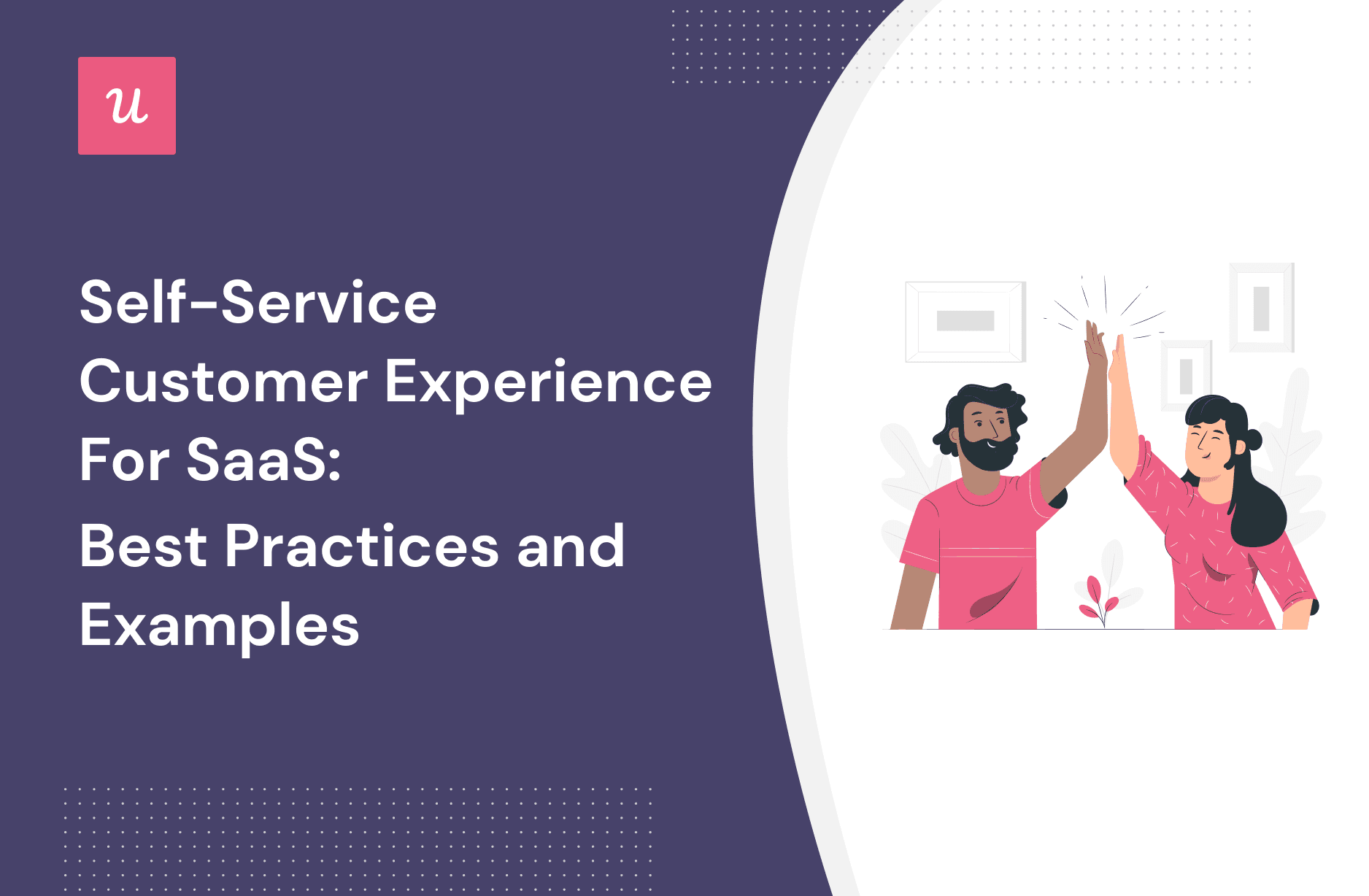Self Service Customer Experience For SaaS: Best Practices and Examples

A self-service customer experience has no downsides.
On the customer side, it provides a seamless experience that empowers customers to use your product without any friction. And on the business side, It can help you reduce support costs, improve customer loyalty, boost product adoption, and drive revenue growth.
But how do you provide a smooth self-service experience that drives real benefits? Let’s go over some best practices and examples so you can implement them yourself.
TL;DR
- Self-service customer experience is a tech-support model where companies provide customers with the resources to find answers to problems and achieve their goals inside your app—without relying on human assistance.
- Here are five best practices for implementing a self-service experience:
- Implement an in-app resource center to provide multiple ways to solve their issues inside your app.
- Show customers how to use your product step-by-step with in-app guidance and use segmentation to personalize it.
- Add a passive feedback widget inside your app so users can submit bug reports or rate their customer experience without getting interrupted.
- Use AI chatbots to provide instant support as customers prefer self-service over waiting for human agents.
- Building a community where users can share their ideas, discuss various topics, share knowledge, and make social connections.
- Here are five examples of customer self-service that you can learn from and apply to your product:
- Userpilot’s in-app resource center for self-service support.
- Komminicate’s interactive walkthrough for in-app guidance.
- Miro’s in-app surveys for collecting passive feedback.
- Gleap’s AI chatbot can substitute their support team when they’re off.
- Mixpanel’s Slack channel where they host a healthy product community.
- Userpilot is the most cost-efficient tool to build an in-app resource center with personalized resources and create personalized onboarding flows based on advanced segmentation.
- Unless you want to code, why not get an Userpilot demo and try to create your own in-app knowledge hub?
What is customer self-service?
Self-service customer experience is a tech-support model where companies provide users with the resources to find answers to problems and achieve their goals inside your app—without relying on customer service teams.
It can include features such as knowledge bases, chatbots, in-app guides, FAQs, forums, video tutorials, and more. Plus it can leverage software to provide personalized support based on the user segment.
5 best practices to enhance self-service customer experience
Self-service can reduce online support costs, increase operational efficiency, and boost customer satisfaction. But how do you create a self-service customer experience that’s engaging and helpful?
Here are five best practices for implementing a self-service experience:
Build a customer self-service portal
Great customer service is essential for any business, and the advantage of implementing self-service support is that you don’t have to be online 24/7 to attend to every single customer query.
That’s why you create a help center, to provide multiple ways to solve their issues. Which includes resources such as knowledge base articles, documentation, video tutorials, and support tickets right from the product UI.
Now, if you implement an in-app resource center, users won’t have to leave your app, google your website, scroll down to find the support button, and browse messy documentation to find answers—as they can instead do it with two clicks.
This way, your customer service reps will save time since they don’t have to answer repetitive queries and leave important requests in the queue.

Provide training with interactive in-app guidance
During onboarding, instead of directing users to external resources, you can show customers how to use your product step-by-step within the app itself.
This type of in-app guidance can help customers:
- Adopt core features quickly and reach activation faster.
- Discover advanced functionalities that add value.
- Achieve their milestones more easily.
- Reduce friction across the user journey.
Plus, if you segment users, you can provide personalized in-app guidance according to their use case, job to be done (JTBD), and the journey stage—building rapport and engaging users in the process.

Allow users to submit feedback with passive feedback tabs
Collecting feedback and responding to it is key to building customer relationships.
However, self-service feedback isn’t about triggering a survey at random times, but about passive feedback.
A passive feedback widget is an unobtrusive way of asking users to submit bug reports or rate their customer experience without interrupting their workflow.
For example, you can leave a feature request widget so users can tell you how you could make the product more useful, engaging, and competitive:

Enable self-service support with chatbots
Chatbots are a fast and easy way to seek help, find information, and resolve issues without having to navigate anything.
Just like in-app help centers, chatbots can provide instant support for customers who prefer self-service over waiting for human agents—reducing support costs and workload for businesses by handling repetitive queries.
But with the rise of AI in customer service (and in the rest of the world too), you can offer more than predetermined answers (like the screenshot below). For instance, you could use AI chatbots that use machine learning to throw deeper responses and solve complex problems.

Build community forums for your users
Now, sometimes humans need answers from other humans.
One way to provide human responses without involving your customer service team is by building community forums.
Here, users can share their ideas, discuss various topics, share knowledge, and even make social connections with other users—without ever requiring your time.
The only downside is that building a community can be quite hard and you’d probably need to hire a community manager to act as a moderator.

Best examples to improve your customer self-service strategy
Not all self-service solutions are created equal. So let’s look at five examples of customer self-service that you can learn from and apply to your own product.
Userpilot builds a comprehensive resource center
At Userpilot, users are free to explore the product and features on their own.
However, if something isn’t clear, they can find a guide from our in-app knowledge base. Which offers different types of self-serve resources that cater to different needs.
For example, if they want to watch the interactive guide on creating a user segment, the knowledge base will trigger it in the app without disrupting the user experience.

Kommunicate provides a self-serve guide with interactive walkthroughs
When getting started with Kommunicate’s product, it’ll trigger relevant interactive walkthroughs as you discover the basic features—like customizing the chat widget.
It triggers short tooltips as the user interacts with each part of the feature, focusing their attention only on their next step. This in turn makes them more likely to engage, finish the first phase of the onboarding, and reach activation without having to leave your app.
These in-app walkthroughs improve onboarding because they only trigger one feature at a time, so the user can stay busy (in a productive way) without feeling overwhelmed with information.

Miro offers passive feedback options
Miro excels at collecting passive feedback without disrupting the customer experience. They include in-app surveys in every feature in a subtle way so customers can provide feedback (and only when they have the initiative to do so).
They use many types of surveys, but the most remarkable is their smiley survey where you only need to click on one emoji to express how you feel about the product.
Such a survey is brilliant as it’s super quick to answer and doesn’t cost much of your time:

Gleap uses an AI chatbot for online customer support
Even if you’re off, you must provide online customer support 24/7.
Gleap, for example, offers online customer support with a top-notch AI chatbot while their support agents are away.
The AI chatbot is not only easy to access inside the app, but it also allows you to type any query and receive a relevant response. So at least you’re not left to your own luck when you get stuck or are facing a problem.

Mixpanel hosts a community forum on Slack
Hosting a Slack channel is an easier way to build a community without having to design a forum on your website.
Mixpanel, for example, invites all their users to join their product community (while also asking for some relevant information on the signup page) where they can ask questions, discuss topics, and meet other product managers.
The fact that they’re using a third-party platform means that they can effortlessly moderate their community, create rules, and interfere when needed. Plus, it also serves as a way to connect with users, get feedback, and understand their pain points and goals.

How to provide multiple self-service options with Userpilot?
Sure, you can implement all the best practices with your coding skills. But what if you can’t code? Or what if your dev team is not available for implementing self-service options?
Userpilot is the most cost-efficient product we know that provides self-service tools that don’t require coding skills.
Here’s how:
Build a resource center with various help modules
The first thing you can do with Userpilot is create an in-app support hub.
But throwing resources to your customer’s face isn’t enough—they also need to be the right resources.
When building your help center, you can add and group different modules and content types such as links, videos, flows, and even custom Javascript code. This way, customers don’t have to browse through a sea of irrelevant articles to find what they need.

Plus, you can add specific targeting options to your knowledge base so the content only shows up based on:
- A specific URL path. To limit the resource center on specific URL paths within your web app.
- User segment. To show the content to a specific segment that you’ve previously created.
- Localization. To show the content in different languages depending on the user’s country.
- Events triggered by the user. Make events such as NPS surveys, behavioral data, and other user properties trigger the content.

Create interactive in-app guidance for self-serve training
Better yet, Userpilot can create onboarding flows with different UI patterns (such as tooltips, slideouts, and modals). And you can also trigger in-app messages based on specific events, in-app behaviors, and the user’s stage in the journey.
You just need to create an onboarding flow and choose a template:

Additionally, you can hyper-target your onboarding flows to relevant users thanks to the advanced segmentation features. Which can segment your users based on a wide range of attributes such as ID, roles, content engagement, feature usage, NPS response, and more.

Conclusion
By now, you know a self-service customer experience should be:
- Fast.
- Widely available.
- Personalized.
- Always improving on feedback.
There’s no doubt that if you want to scale your SaaS, you need to go the extra mile with your customer service strategy—which is only possible with self-service models.
So, unless you want to code it yourself, why not get an Userpilot demo and try to create your own in-app knowledge hub?

